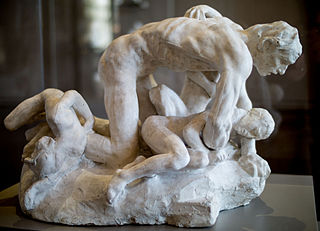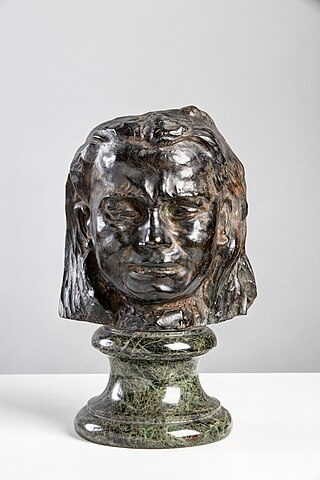
François Auguste René Rodin was a French sculptor generally considered the founder of modern sculpture. He was schooled traditionally and took a craftsman-like approach to his work. Rodin possessed a unique ability to model a complex, turbulent, and deeply pocketed surface in clay. He is known for such sculptures as The Thinker, Monument to Balzac, The Kiss, The Burghers of Calais, and The Gates of Hell.

The Thinker is a bronze sculpture by Auguste Rodin, situated atop a stone pedestal. The work depicts a nude male figure of heroic size sitting on a rock. He is seen leaning over, his right elbow placed on his left thigh, holding the weight of his chin on the back of his right hand. The pose is one of deep thought and contemplation, and the statue is often used as an image to represent philosophy.

The Burghers of Calais is a sculpture by Auguste Rodin in twelve original castings and numerous copies. It commemorates an event during the Hundred Years' War, when Calais, a French port on the English Channel, surrendered to the English after an eleven-month siege. The city commissioned Rodin to create the sculpture in 1884 and the work was completed in 1889.

The Musée Rodin of Paris, France, is an art museum that was opened in 1919, primarily dedicated to the works of the French sculptor Auguste Rodin. It has two sites: the Hôtel Biron and surrounding grounds in central Paris, as well as just outside Paris at Rodin's old home, the Villa des Brillants at Meudon, Hauts-de-Seine. The collection includes 6,600 sculptures, 8,000 drawings, 8,000 old photographs and 7,000 objets d'art. The museum receives 700,000 visitors annually.

The Gates of Hell is a monumental bronze sculptural group work by French artist Auguste Rodin that depicts a scene from the Inferno, the first section of Dante Alighieri's Divine Comedy. It stands at 6 metres high, 4 metres wide and 1 metre deep (19.7×13.1×3.3 ft) and contains 180 figures.
Bernard Gerald Cantor was the founder and chairman of securities firm Cantor Fitzgerald.

The Walking Man is a bronze sculpture by the French sculptor Auguste Rodin. This sculpture was made in 1907.

Cantor Arts Center is an art museum on the campus of Stanford University in Stanford, California, United States.

Crouching Woman is a bronze sculpture by Auguste Rodin.

Saint John the Baptist (preaching) is a bronze sculpture, by Auguste Rodin.

Cybele is a sculpture by French artist Auguste Rodin. It is one of the first of Rodin's partial figures known as "fragments" to be displayed as sculpture in its own right, rather than an incomplete study.

Pierre de Wissant is a bronze sculpture by French artist Auguste Rodin, part of his sculptural group The Burghers of Calais. This sculpture represents one of the six burghers who, according to Jean Froissart surrendered themselves in 1347, at the beginning of the Hundred Years' War (1337–1453), in order to save the inhabitants of the French city of Calais from the English laying siege to the city.

Ugolino and his sons is a plaster sculpture by French artist Auguste Rodin, part of the sculptural group known as The Gates of Hell. As an independent piece, it was exhibited by its author in Brussels (1887), Edinburgh (1893), Genoa (1896), Florence (1897), Netherlands (1899) and in his own retrospective in 1900.

Andromeda is a sculpture by the French artist Auguste Rodin, named after Andromeda. It is one of the sculptures produced as part of his The Gates of Hell project and appears on the left door next to the personification of Day and on the right door as part of the group showing a falling winged genius.

Eustache de Saint Pierre is a sculpture by Auguste Rodin, now in the Museo Soumaya in Mexico City. It was conceived between 1885 and 1886 as part of his The Burghers of Calais group. The other figures in the group were also cast as individual figures.

Glaucus is a sculpture by the French artist Auguste Rodin, first conceived in 1886 as a representation of the mythological figure Glaucus, son of Poseidon. Originally made in plaster, bronze casts of it are now in the Brooklyn Museum and the Museo Soumaya.

Jean de Fiennes, in real life Jean de Vienne, is a sculpture by the French artist Auguste Rodin, first produced between 1885 and 1886. A bronze cast of it is now in the Museo Soumaya in Mexico City.

Polyphemus is an 1888 sculpture by Auguste Rodin, showing Polyphemus and his love for the Nereid Galatea, as told in Book XIII of Ovid's Metamorphoses.

Mask of a Weeping Woman is a sculpture by Auguste Rodin, initially produced as a pair with Weeping Woman for the first version of his The Gates of Hell in 1885. The two pieces were intended to appear on the centre of each panel. They were later moved by Rodin himself, who instead placed Mask on the lower part of the left panel.
Andrieu d’Andres is a figure by the French artist Auguste Rodin. It is part of his group of the six figures The Burghers of Calais.




















